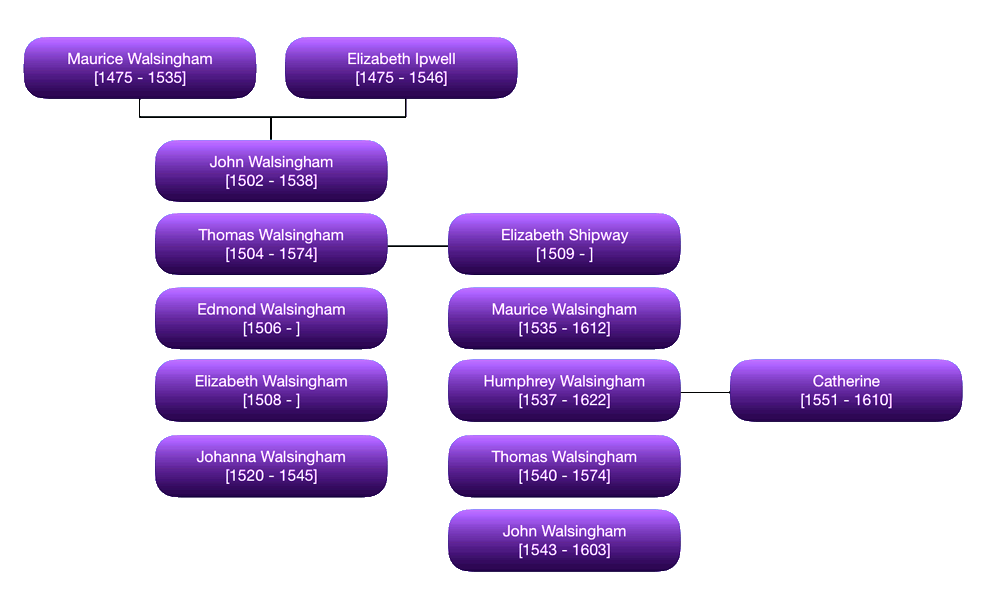 |
|
 |
|
| Walsingham Coat of Arms |
At Broadwas, upon a stone between the chancel and the church, were these arms: Paly of six Argent and Sable a fesse Gules, with a crescent for difference. Walsingham. 'Underneath lie the bodies of Humfrey Walsingham, who died 22nd June, 1622, aged 91, and his wife Catherine, who deceased 5th June, 1610, aged 59.'
Humfrey Walsingham's, family in the two previous centuries had been lords of a manor in Cofton Hacket, and who according to Grazebrook, are mentioned in the "Visitation Book," as of 1634, as still resident in Cofton Hacket.
Walsingham held a quarter of a knight's fee in Coston Richard. John Walsingham was apparently lord of the manor in 1525, and it was held in 1567 by Edward Walsingham, who had inherited it from his brother John and his father John. Before 1594 it had been acquired by William Child, the lord of Coston Hackett, and has since followed the same descent as that manor.
Francis Walsingham - Humphrey's nephew
FRANCIS WALSINGHAM, (1577–1647), Jesuit, who assumed the name John Fennell, the son of Edward Walsingham of Exhall, near Alcester, Warwickshire, was born at Hawick, Northumberland, early in 1577. His father died before his birth, and his mother, who was a Roman catholic, brought him to London. His uncle, Humphrey Walsingham, who was kindred of Sir Francis, placed him at St. Paul's school. As the result of his instruction there he read the protestant divines Foxe, Jewell, Calvin, and Beza, and in 1603 was ordained deacon by Martin Heton, bishop of Ely. Doubts were raised as to the validity of his orders and of his belief by reading the 'Manual' of Robert Parsons (1546–1610) [q. v.], and in October 1606 Walsingham entered the English College at Rome. He was ordained priest on 12 April 1608, and early next year, having entered the Society of Jesus, he visited England, and there published his 'Search made into Matters of Religion, by F. W., before his change to the Catholike' (s. l. 1609, 4to; 2nd edit. St. Omer, 1615). The work was dedicated to James I, to whom the author states he had formerly submitted his religious difficulties. Down to the time of Alban Butler it has been frequently commended to those showing an inclination to Roman Catholicism, and has been often reprinted and abridged. In the controversial parts, and especially in the attack upon the 'falsities' of Matthew Sutcliffe [q. v.], it is probable that the author was aided by Father Parsons. In 1618 Walsingham published his 'Reasons for embracing the Catholic Faith' (London, 16mo). Two years previously he had been formally attached to the 'English mission,' and served in Leicestershire. In 1633 he removed to the college of the Immaculate Conception, Derbyshire, and there he died on 1 July 1647. He left in manuscript at the convent at Newhall, Essex, a little prayer manual, 'The Evangelique Pearle,' dedicated to the abbess of the English nunnery at Pontoise.
Around the time of Humphrey Walsingham's birth another famous Walsingham was born, and may have been a distant relative.
Sir Francis Walsingham (c 1532 - 6th April, 1590) was principal secretary to Queen Elizabeth I of England from 20th December, 1573, until his death and is popularly remembered as her spymaster. Born to a well connected family of gentry, Walsingham attended Cambridge University and travelled in continental Europe before embarking on a career in law at the age of twenty. A committed Protestant, during the reign of the Catholic Queen, Mary I of England he joined other expatriates in exile in Switzerland and northern Italy until Mary's death, and the accession of her Protestant half sister, Elizabeth.
Walsingham rose from relative obscurity to become one of the small coterie who directed the Elizabethan state, overseeing foreign, domestic and religious policy. He served as English ambassador to France in the early 1570s and witnessed the St. Bartholomew's Day massacre. As principal secretary, he supported exploration, colonization, the use of England's maritime strength and the plantation of Ireland. He worked to bring Scotland and England together. Overall, his foreign policy demonstrated a new understanding of the role of England as a maritime, Protestant power in an increasingly global economy. He oversaw operations that penetrated Spanish military preparation, gathered intelligence from across Europe, disrupted a range of plots against Elizabeth and secured the execution of Mary, Queen of Scots.Sir Francis Walsingham
©peh

